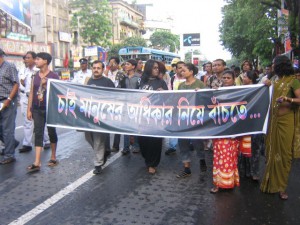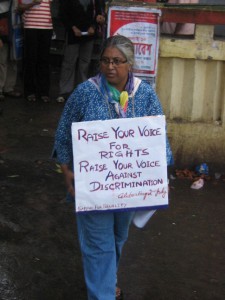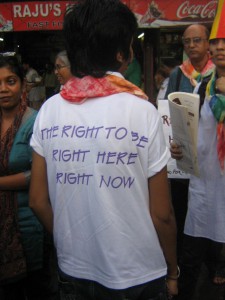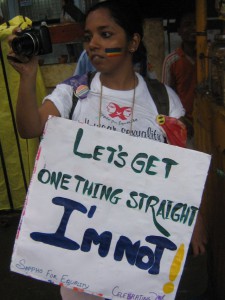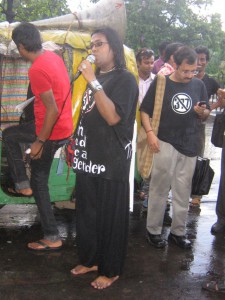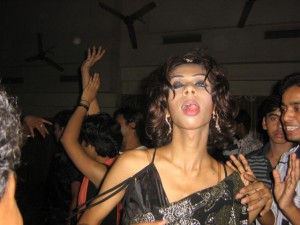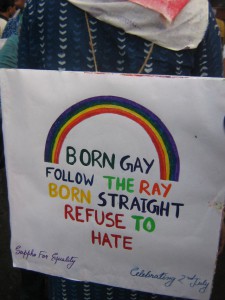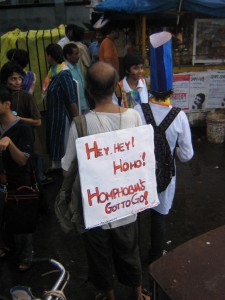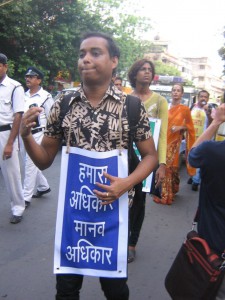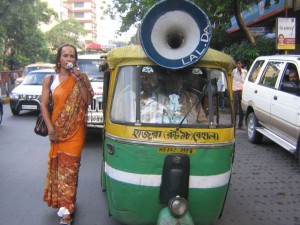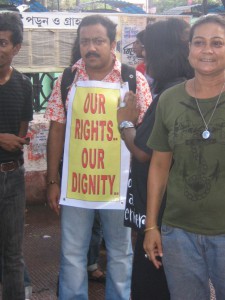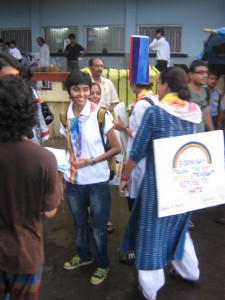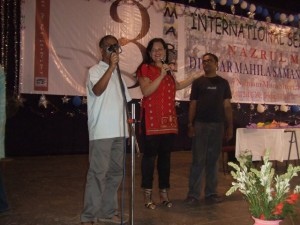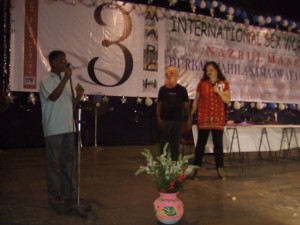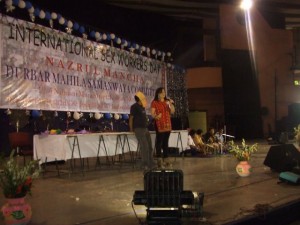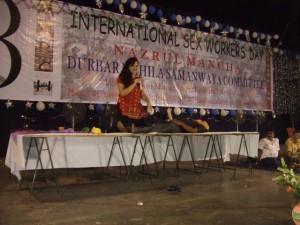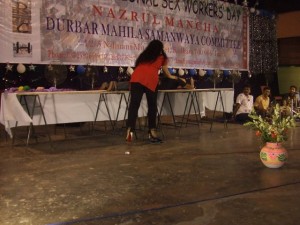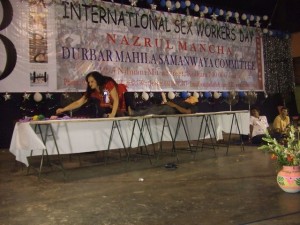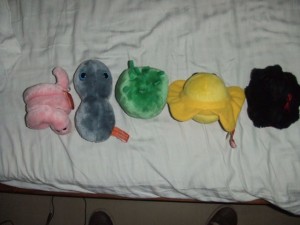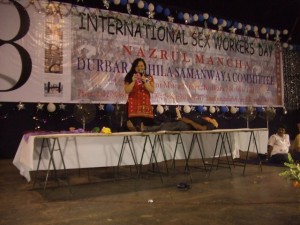I got to attend Kolkata Gay Pride as well which was on the 2nd of July. I arrived in Kolkata on the 1st of July after attending the Chennai pride and spending a few days in Bangalore. My friend Sourendra from Mumbai had introduced me to Mr. Rajshrei Chakrobarty who was Secretary of Dum Dum Society and one of the organizers of Kolkata Gay Pride. I knew that Kolkata was the first city in India to start gay prides and I was expecting it to be the biggest one in India this year as well but when I arrived at the parade venue I was shocked to see that there were hardly 50 people in the parade.
Mr. Chakrobarty told me about the reason of few people before I asked him about it. He said that most of the organizations working on gay rights in Kolkata boycotted the parade because of some internal politics hence they could not make the parade as big as it used to be in the past. He said that Dum Dum Society and one other organization called Anandam were the only two organizations that organized the pride this year. I was surprised to hear that most of the organizations boycotted the parade but at the same time I was happy also that at least someone organized it.
The parade started from Jatin Das Park near Hajra crossing and ended at the Academy of Fine Arts. The parade started with only 40-50 participants but it was really interesting. I have been to all the big prides taking place in India within past one year and Kolkata one was the most liberal parade I had ever seen in India. I noticed that nobody was wearing the masks. They had an auto rickshaw with loudspeakers and the participants of the parade were singing songs of human rights, equal rights and gender equality. They were passing out pamphlets which had writing about LGBT rights.
It was raining most of the time during the parade but it could not stop people from joining the parade. The parade started with 40-50 people and ended with at least 100 or 120 people. A lot of people joined at the Academy of Fine Arts where the parade ended. In fact, the end was the most interesting part of the parade for me. At the academy a lot of young lesbian couples joined the parade. I had never seen that many lesbians before in any of the parades whether Mumbai, Delhi or Chennai and very interesting thing was that these girls were young.
They being young surprised me the most because in India lesbians coming in public and very rare and whenever I see any lesbian I always find them over 35, living either alone or with their partner and always have no connection with the family but these young girls were really young and I don’t think they were living alone or had no connection with their family. They were so open and they knew that their parents were going to know about their sexuality if they participated in the parade but they still did it which meant their parents either knew about it or these girls knew that their parents would not mind knowing that their daughter was a lesbian. I liked it.
The parade ended with speeches from Mr. Ranjeet Sinha, Mr. Rajarshi Chakrobarty and a few other social activists. After the parade ended, I went with Mr. Chakrobarty to attend a cultural dance and performance program organized by an organization called Saathi. This program was basically a platform for the LGBT community to show their talent and have fun. I spent about an hour at the program and then headed back to my hotel for overnight. Dum Dum Society had organized a cultural program about 2 hours bus ride away from Kolkata two days after the parade.
This program was really something and I could easily see how Dum Dum Society was working honestly with the LGBT community and how they had strengthened the people belonging to the community. The program was just awesome. They had several dance performances, some of them based on Bollywood songs and some on traditional Kolkata songs, they had fashion shows where all the clothes were designed by the people belonging to LGBT community and I was shocked to see the quality of the program. It was really awesome and I enjoyed it a lot. The chairman of municipality was the chief guest of this program.
There were more people in this program than the parade. I think there were at least 500 people at this program. I was able to interview a few people including Mr. Rajshree Chakrobarty, Mr. Ranjeet Sinha and a few other people from LGBT community and all of those interviews were really interesting. Mr. Chakrobarty told me about the history of gay activism in Kolkata. He said that it first started in Kolkata in the year 1989 which clearly shows that they were one of the few who started gay activism in India and at present there are about six or seven organizations working on LGBT rights in Kolkata.
I asked about the condition of the LGBT community in Kolkata and he said that the condition of the LGBT community living in Kolkata city area is in much better condition than the LGBT community living in the other districts or suburbs of Kolkata because of the influence of media and availability of organizations working in the city. He told me that the condition of the LGBT community is much better in Mumbai and Delhi when compared with Kolkata because Mumbai had started working on this issue way before Kolkata and since Kolkata is the poorest metropolitan city in India, the life of LGBT community is not easy here.
Mr. Chakrobarty told me something really interesting that transgenders are more discriminated against when compared with gay community because their sexuality is more visible but when we talk only about discrimination then yes, the whole LGBT community is discriminated against on various levels. I asked the same question which I ask to other people whom I interview about many people thinking that homosexuality is a disease or a fashion and it being possible to change it by getting people married or making them practice yoga (Baba Ramdev Says). His answer was like the others in that he said it is not possible to change somebody’s sexuality by getting them married.
He said that many people get married with a woman under family or social pressure but they are not happy and they practice sex with a same sex person even after marriage. I know several people who do this and I definitely believe that it just not possible at all to change somebody’s sexuality by getting them married or teaching them yoga. I asked him about the existence of the LGBT community in Hindu culture and religion and he told me several stories which proves that the LGBT community has always been in existence. I also believe the same because I have read several Hindu sacred books and have visited temples where same sex behavior sculptures are shown.
He told me something really intersting that I did not know before. He told me when Hanuman went to Sri Lanka to search for Sita, he saw that Ravan had kept several women but he was not able to give time to all of them hence these women had started making sexual relationships with each other which clearly shows that there were lesbians during Rama’s time also. I asked him about the revocation of section 377 and he told me that homosexuality was accepted in Hindu society and temples of Kamasutra and several other books clearly proves it but British made it illegal and this judgment of the High Court of Delhi was a right judgment and most probably it will help changing the society in the future.
It was really informative talking with him. He was a real and honest social worker working on LGBT rights in Kolkata. After Mr. Chakrobarty, I got to meet Mr. Ranjeet Sinha who was a transgender himself and was working with transgenders in Kolkata and nearby districts. He also told me about the problemswhich the transgender community was facing in Kolkata. He told me that there are reservations on the basis of caste and religion but no reservation for transgenders. He demanded for a separate toilet system at public toilets because when he goes to the male toilet, people make fun of him and if he goes to the female toilets then women are scared.
Mr. Sinha told me a story of his one friend, who was a transgender Hijra himself and was a well known social activist in West Bengal and was suffering from AIDS. He had to go to the hospital once and the doctors forcibly took off his clothes, made him wear men’s clothes and only then they admitted him in the hospital. Mr. Sinha demanded that their identity should also be recognized on official documents such as passport and voter ID card. He said that all the NGOs are focusing only and only HIV and AIDS but they must do something on other issues also related with LGBT community. He mentioned all the South Indian states, especially Chennai, as being especially progressive working on transgenders issues.
He also said that it is not possible to change someone’s sexual identity and if one tries to do so then the result is always horrible. Kolkata taught me so many new things. I was especially thrilled to see the work of Dum Dum Society. It was really a nice experience meeting with people like Mr. Chakrobarty and Mr. Sinha and so many other people who helped me in Kolkata and educated me about their issues and their work. I hope to go their next year as well and will hope that all the organizations that had boycotted the parade this year would join the parade again by ending the internal politics and making Kolkata a city of equal rights for everyone.
Please click here to see more pictures:

